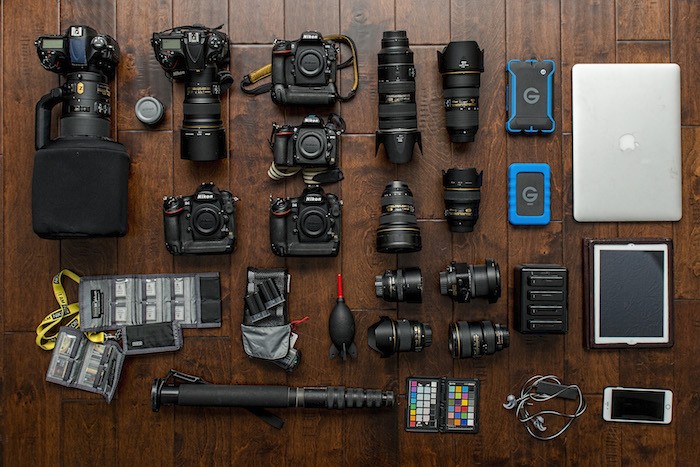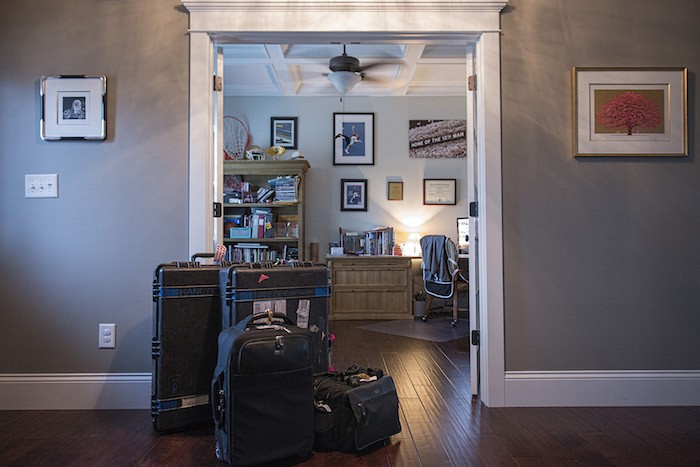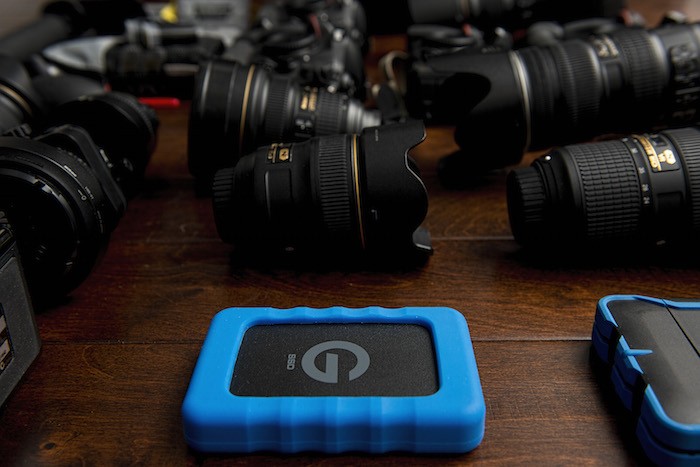
Andrew’s Pre-Game Gear Assembly
Top-level sports photographer Andrew Hancock was kind enough to talk with me last week about his approach to Super Bowl 50 and how he deals with the logistical side of managing remote cameras, memory cards and data transfer during and after the game. We see plenty of sidelines action and the resulting images from sports shooters; however, we rarely get a peak into the hard work and planning that goes into making those opportunities possible.
Andrew is on assignment for ESPN at Super Bowl 50 this week. Before the game ever gets underway though, he’s worked for several days planning, packing and setting up remote cameras.
Andrew, who is also a Nikon Ambassador, shoots a variety of Nikon DSLRs and lenses. His gear bag for the Super Bowl will include:
- (1) Nikon D4s
- (2) Nikon D4
- (2) Nikon D810
- (1) Nikon D750
Nikon will be on hand at the Super Bowl and he hopes they will have some Nikon D5 bodies that he can use during the game. However, the D5 would just be icing on the cake and his camera bag will have what he needs to get his shots.

When he arrives in Santa Clara, Andrew will be looking for options to set up his remote cameras depending on where the NFL will allow him to position them. In the past, he’s positioned cameras overhead, in tunnels and just about anywhere that will get him a shot that no one else has. He was the first photographer to have a shot from the inside of the finish line at the Kentucky Derby in its 141 year history thanks to going the extra mile by setting up the camera (a D750 and 14-24mm lens) the day before and bringing his own ladder to make it happen. Needless to say, it’s worth a few minutes of your time to head over to Andrew’s portfolio and check out some of his remote shots.
He will rely on multiple editors, assistants and runners before and during the game to get images to publication and social media as soon as possible after they are shot. During all of the pre-game coverage, he will have a plan with his runners to meet and pick up cards at certain locations and times throughout the day.
Andrew loves the XQD card option on the Nikon D4s (he’s also a big fan of the dual XQD card slots on the D5). XQD cards keep data throughput high at both the capture and offload stage, which is critical for sports photography. The editors and assistants in the media room don’t need a slower CF card holding up their workflow during up-to-the-second coverage of a game as big as the Super Bowl.
As Andrew shoots, he will tag key images along with voice memos (on his D4/D4s bodies) to give the editors context of the shot. Once the game begins, they will do card runs at scripted points in the game (like in between quarters). However, they will likely have dozens of card runs throughout the game when the situation calls for it. Big plays, scoring plays, turnovers and injuries on the field are all important pieces of the story that their editors will want immediately to help them tell the story of the game.
Andrew gives an example of the College Football Playoff National Championship between Alabama and Clemson:
I had 48 individual card ingests from the game. With multiple ingests sometimes occurring from a single card run, it is safe to say we had over 30 runs from the game. Another advantage of frequent runs is that it keeps an editor from being slammed with a large image dump of 600-1000 images which can start to bottleneck workflow.
As I mentioned earlier, Andrew digs the XQD card format because of the speed (his D5 bodies on pre-order will only be the XQD version) and pairs it with a storage system built around the G-Technology EV series for the best performance during the capture and throughout his workflow.

The ESPN editors will ingest the images onto a MacBook Pro using PhotoMechanic for picking selects and then transferring the selects to ESPN’s server using MerlinOne. To keep the files safe locally, all of the images are copied to the MacBook Pro’s internal drive and copied out to two external G-Technology drives, one of which is Andrew’s drive so that he has his own copy of the images. Once Andrew gets back home, his G-Drive EV gets transferred over to a G-SPEED Studio XL.
Andrew is a fan and brand ambassador for G-Technology. As he puts it:
I have to work and move as fast as possible so having the fastest possible options at my disposal regarding data management is paramount… as is security and fortunately I get both of those from G-Technology. They keep me moving and keep my images secure. With constantly being on the go and not always knowing where I am going from one week to the next, I need something that not only is fast but reliable and can stand up to some abuse. As a result, my G-Drive ev Raw SSD and G-Drive ev ATC are in my bag every single time I leave the house.
You can see the images above, but below is the gear list of what Andrew is taking to the Super Bowl.
Traveling with Andrew:
- D4s
- D4
- D4
- D810
- D810
- D750
- 400mm f2.8
- 70-200mm f2.8
- 24-70mm f2.8
- 14-24mm f2.8
- 35mm f1.4
- 20mm f1.8
- 50mm f1.4
- 1.4 TC
- 300mm f4
- 24mm PC f2.8
- MacBook Pro
- 1TB G-Drive ev Raw SSD
- 1TB G-Drive ev ATC
- Lexar USB 3.0 tower card reader
- Pocket Wizard Multimax transcievers
- Manfrotto magic arms and assorted grip gear
Waiting for Andrew in Santa Clara will be three Nikon D4s bodies and a 600mm f4 lens.
On Andrew’s body during the game:
- D4s – 600mm f4
- D4s – 400mm f2.8
- D4s – 70-200mm f2.8
- D750 – 24-70mm f2.8
- D4s – 14-24mm f2.8
Remotes Andrew hopes to do if permissions are granted by the NFL:
- D4 – 300mm f4
- D4 – 24mm PC
- D810 – 17-35mm f2.8
- D810 – 20mm f1.8
I appreciate Andrew for giving us all a peak behind the curtains of what goes into the planning and logistics of shooting this year’s Super Bowl 50. I’m looking forward to seeing his images during and after the game.
You can follow Andrew on hits website andrewhancock.com, Instagram, Facebook and Twitter.
All images copyright Andrew Hancock and used with permission.
Copyright/DMCA Notice: The RSS entry was originally published on Photography Bay. RSSID#794326